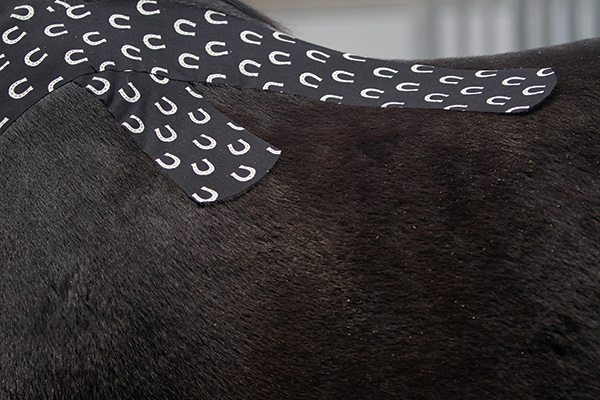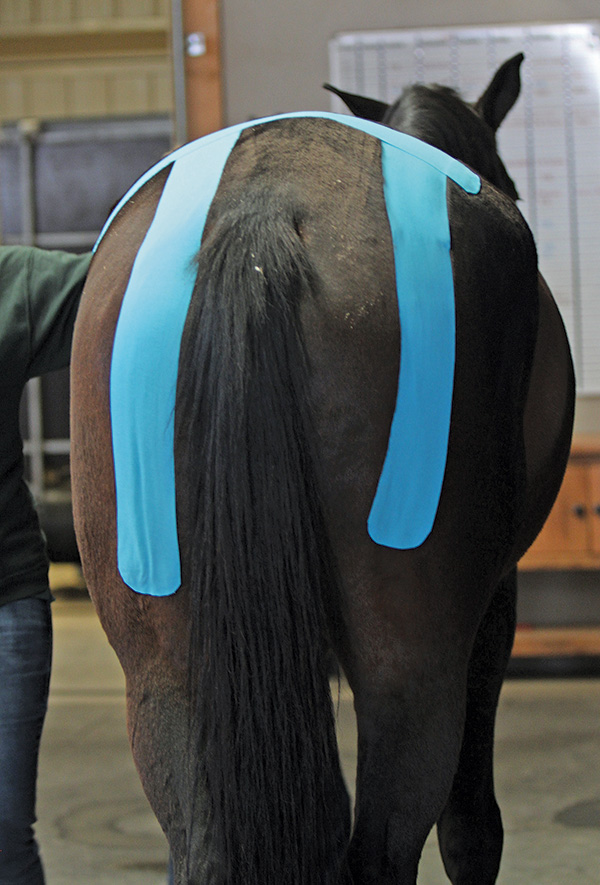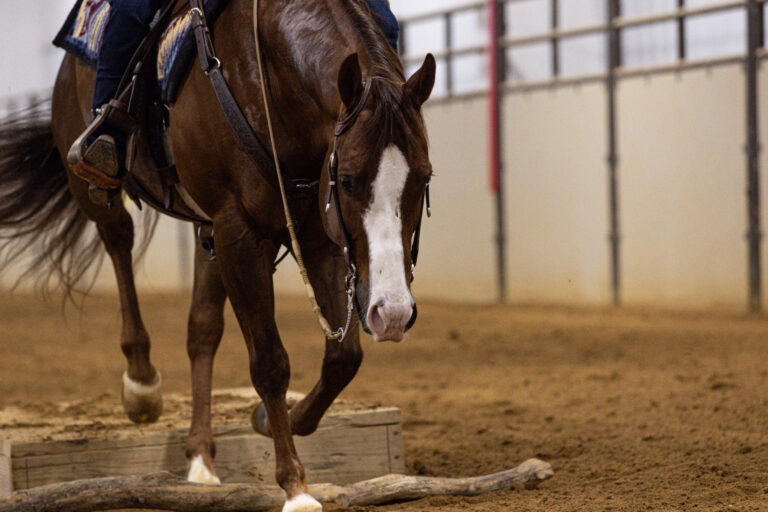You’ve probably noticed Olympic athletes wearing tape on different parts of their bodies when they competed for gold. But did you know that your horse can benefit from the same tape these athletes use? While humans have been using different taping methods for several decades, it’s only now starting to become a popular alternative therapy for your equine partner.
[READ: 5 Cheap & Easy Ways to Improve Horse Health]
There are several strategies that can be applied to taping your horse, and each has different results. You can tape your horse to help with muscle soreness and muscle relaxation, and when applied properly it can even reduce swelling in an injury. Always consult your veterinarian first when an injury is involved, and then discuss with your practitioner what taping can achieve. While taping is considered a safe alternative therapy, and you can purchase tape on your own, hire a certified practitioner to apply it to your horse to ensure that he’s taped properly for the best results.
If you’re planning on taking your horse to a show, take time to learn and understand the rules regarding taping your horse if he’s competing—or even riding around—at an event. For example, at FEI events your horse can’t compete or wear tape while riding. However, you can tape your horse when he’s unsaddled and in the stable area.
To learn more about kinesiology tape, we asked experts from three tape manufacturers to explain what it is, and to share their advice on how to be successful when using it.
Expert Insight #1
Dr. Rebecca A. McKee, bodyworker and Rock Tape (rocktape.com) clinician and educator.

Taping philosophy: “The stickiness and stretchiness of the tape allows the hair to be lifted off the fascia, which wraps the muscles and connective tissues in your horse’s body and helps bring more circulation to that area,” McKee says. She advises that the stretch in the tape is for your horse’s range of motion; not for wrapping tightly against the skin. “With your horse, less stretch is more. That’s because your horse has an extra muscle layer known as the panniculus, which allows him to feel things—like flies—and move his skin to get rid of them. It also means he’s more sensitive to touch.”
[READ: Healing Products for Horses]
How it works: “This equine tape is similar to the tape swimmers use, so it’ll stay on when you bathe and ride your horse; it’ll even stay on if your horse needs to use a water treadmill,” she says. “Once you apply the tape to your horse, you’ll want to activate the adhesive by rubbing the tape with your hand.” Typically, you can leave the tape on your horse for up to five days, as long as it’s not beginning to peel. “After you remove the tape, I recommend leaving it off for a couple of days so you can evaluate how he’s moving,” McKee shares.
What to avoid: “Try to avoid using tape when your horse is dirty,” she says. “If he’s dirty or shedding, try removing all of the loose hair and then use rubbing alcohol to wipe down and clean the area where you’re applying tape. The tape sticks best to clean, clipped horses.” Avoid using too much stretch when you’re applying the tape. “Because of your horse’s sensitivity,” McKee explains, “too much stretch will cause irritation to the skin.”
Practitioner advice: “Always work with a certified taping practitioner,” she says. “You can find a certified practitioner online, or if you want to learn how to tape your horse, you can enroll in an equine-taping class.”
Expert Insight #2
James Ruder, president of RSB Animal Health and director of Equi-Tape Educational Services, and Dr. Beverly Gordon, chiropractor and founder/developer of Equi-Tape
(equi-tape.com).

Taping philosophy: Taping doesn’t enhance your horse’s abilities; it allows your horse to be more comfortable at the level of riding he’s designed to perform, and it’ll help improve his physical stamina. “Taping lifts the skin and helps feed the area increasing circulation and improving oxygen flow, while helping remove edema and lymph,” Ruder explains.
“Taping works, depending on how you apply it,” Gordon shares. “If you want to decrease swelling, you’ll apply it differently than if you want to support a joint or muscle. The tape also allows full range of motion because of its stretch,” she says.
How it works: “It’s all about application; coat length doesn’t really matter. Before you apply any tape, clean the area and make sure the hair lies flat,” Ruder shares. “Depending on what part of your horse you’re taping, you can leave tape on for several days, but length of time doesn’t necessarily mean better results,” he says. “The tape won’t have the same amount of recoil in a day or two that it did when you first applied it, so it isn’t as effective as times goes on.”
What to avoid: “The tape won’t adhere well when there’s dust, debris, and oil on the hair,” he shares. “Make sure you clean the area you’re applying tape to, and use a dish soap to clean oily spots and break up the grease before you tape anything.” Pay careful attention to keeping the taped area clean. “If debris or foreign matter gets under the tape, it can be irritating and can possibly cause sores.” To avoid this, Ruder recommends applying a polo wrap or support wrap over the tape to protect the application when possible.

“Don’t tape over open wounds, because you don’t want the adhesive on broken skin, potentially causing irritation to your horse,” Gordon adds. “However, you can put gauze over the wound before you tape it. Avoid taping over an active infection, like cellulitis, because you don’t want to increase circulation and possibly have the infection spread.”
Practitioner advice: “Look for a professional equine practitioner who’s been trained and certified to tape your horse,” Ruder explains. “We train practitioners such as equine veterinarians, chiropractors, massage therapists, and acupuncturists who are looking to expand their toolbox of offerings
to customers.”
Expert Insight #3
Linda Delker, project manager for Kinesiotaping (kinesiotaping.com).

Taping philosophy: “Taping works naturally with the body,” Delker says. “By putting tape on your horse’s hair, you’re actually simulating the hair follicle—which originates in the second layer of skin—lifting it up, and bringing blood flow to areas to help with pain or stress. It’s an alternative if you want to support your horse naturally. Taping gives him support and pain relief. It’s also a great way to bond with and care for your horse.”
How it works: While tape made for humans can work on your horse, the equine tape is designed to work directly with the horse’s hair. “The equine version of this tape is stickier than tape designed for humans,” Delker says. “You can leave the tape on for days; you can even bathe your horse with it on.” However, Delker recommends that if you encounter tape that doesn’t remove easily, it’s best to let the skin and hair rest before you re-tape the area to avoid any irritation.
What to avoid: “Don’t use any type of oils, liniments, or fly spray before you apply tape, because it won’t stick properly,” she says. Also, don’t wrap the tape all the way around the leg. “There should always be a gap between the two ends of tape to avoid cutting off your horse’s circulation.”

Practitioner advice: “If you’re looking to work on a high-level problem with your horse, look for someone who’s completed training from a taping company,” she shares. “And the practitioner should have extensive knowledge in the equine anatomy and physiology.”
MORE ALTERNATIVE THERAPY






